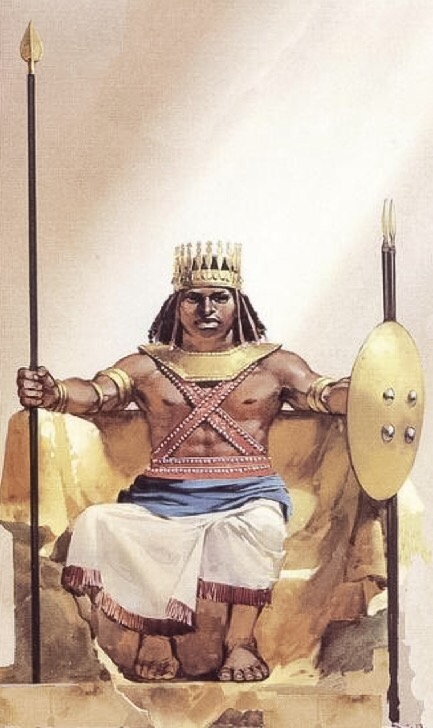 |
| Ezana (Abreha) |
Abreha, also known as King Ezana, was a fourth-century c.e. king who converted to Christianity and subsequently established this faith as the state religion in Axum (Aksum), part of modern-day Ethiopia.
Scholars do not agree on the details of Ezana’s life, but several have documented information about his reign through trilingual inscriptions on stone tablets of the period. Most Ethiopians believe that Abreha, along with his twin brother Atsbeha, inherited the throne of Axum when their father died.
Since the boys were too young to take over the reigns of government, their mother, Sawya (Sophia), served as queen regent from around 325 to 328 c.e. Upon ascending to the throne, Abreha took Ezana as his throne name, and Atsbeha opted for Sayzana.
  |
Ezana and Sayzana were tutored by two Hellenic Syrians who had been rescued as young boys after other occupants of their ship had been either murdered or killed in a shipwreck.
The king subsequently accepted responsibility for the brothers, who were classified as slaves. However, recognizing their unique abilities, he named Aedesius as the royal cupbearer and placed Frumentius in the position of royal treasurer and secretary.
After the king’s death the Syrians continued to tutor the royal twins and served as advisers to the queen. Although the exact date is not known, it is believed that Ezana and Sayzana ascended the throne sometime between 320 and 325.
As monarch, Ezana claimed many titles and is credited with being the first to call himself the "king of kings". He identified himself as the king of Axum, Saba, Salhen, Himyar, Raydan, Habashat, Tiamo, Kasu, and of the Beja tribes.
The kingdom over which King Ezana ruled stretched out on both sides of the Red Sea and extended into what is modern-day Sudan and Somalia. Between 330 and 360 the outside world was made aware of his kingdom. At the time, outsiders referred to Nubia and all of tropical Africa as Ethiopia.
However, residents of Axum generally referred to themselves as Habashats. The term Ethiopian, which means "burned faces", originated with Greek traders and was first used by Ezana in inscriptions that appeared on stone tablets between 333 and 340.
Ezana is considered to have been the ablest and most politically astute of the brothers, and some scholars doubt that he even had a twin. At any rate, Ezana reigned over Axum at a time when it was flourishing as a viable political, economic, and agricultural African state. His tenure was marked by territorial expansion and significant economic growth, and Ezana opened up a major trade route with Egypt.
Consequently, a large number of Greek traders immigrated to Ethiopia in order to take advantage of its rich resources of gold, ivory, spices, and tortoiseshell. By some accounts it was these Greek merchants who first introduced Christianity to Ethiopia.
However, some scholars believe that Frumentius and his brother were entirely responsible for converting the royal family to Christianity. Most sources agree that Frumentius, either by his own initiative or on orders from Ezana, traveled to Alexandria to ask Patriarch Athanasius (c. 293–373) to send a bishop to start a church in Axum. Instead, the patriarch appointed Frumentius as the bishop.
From the date of his return, somewhere around 305, Frumentius devoted his life to evangelizing. Within a few months tens of thousands of Ethiopians from all social classes had become Christians. Evidence shows that early in their tenure as monarchs of Axum, Ezana and Sayzana paid allegiance to pagan gods.
Ezana often called himself the "Son of Mahrem", which was equivalent to identifying himself with Ares, the Greek god of war. After the brothers’ conversion to Christianity, Axumite coins most often depicted the cross, or sometimes multiple crosses.
After his death on the battlefield at around 25 years of age, Ezana was buried in a rock-hewn church that still stands in present-day Ethiopia. Sayzana became the sole monarch, governing for the next 14 years.
Upon Sayzana’s death, he was buried beside his brother. The church of Ethiopia subsequently canonized both Abreha and Atsbeha, and Ethiopians honor these saints each year on October 14.
There is some evidence that the Ark of the Covenant was brought to Axum from Jerusalem in the 10th century where it was placed in the sanctuary of St. Maryam Tseyon. As a result of this belief, Axum is considered Ethiopia’s holiest city. Archaeologists are in the process of uncovering relics that have traced the history of the area back to the first century c.e.